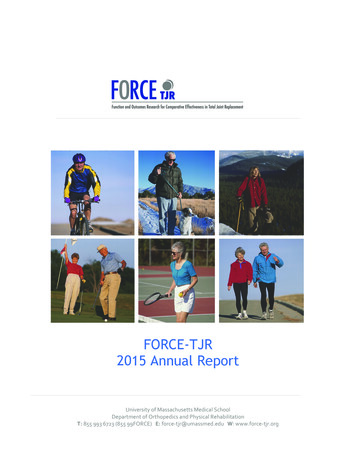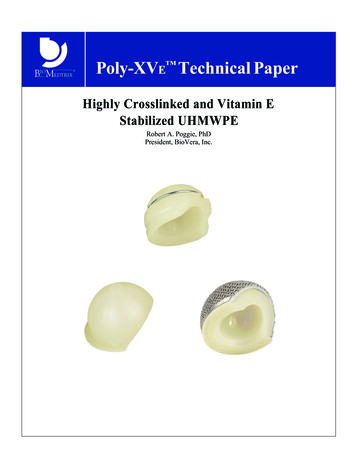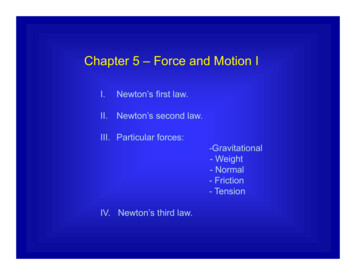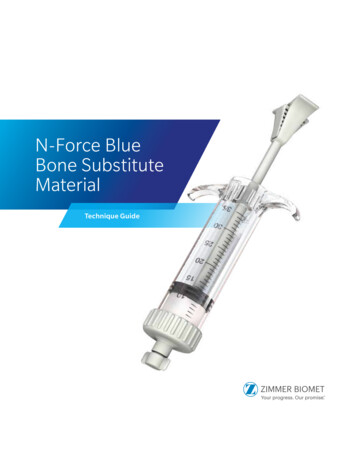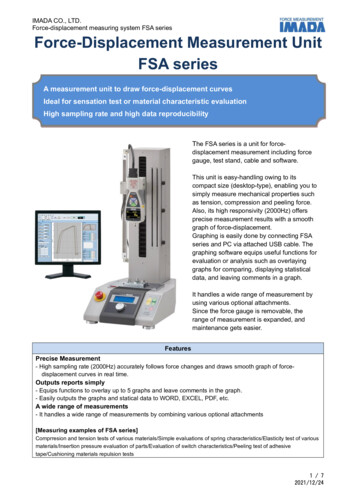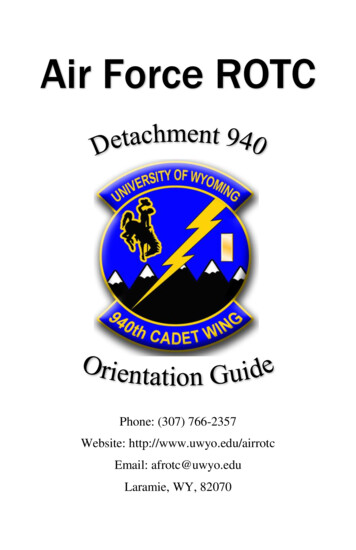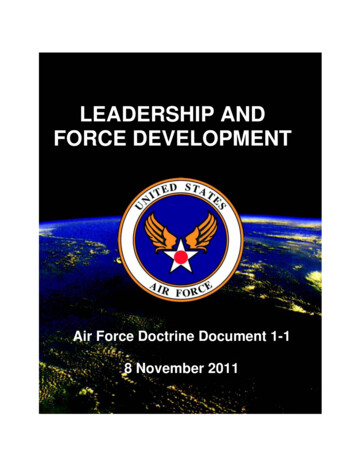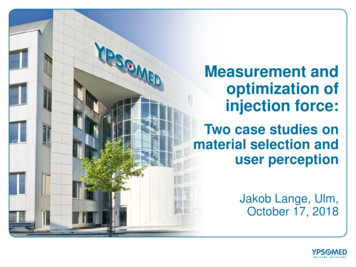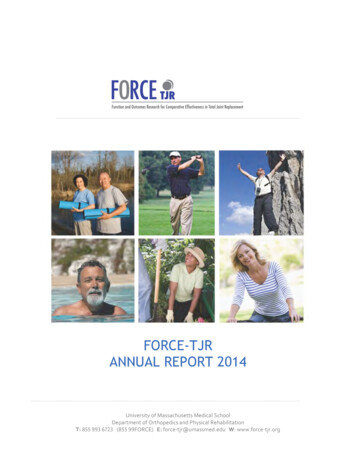
Transcription
TJRFORCE-TJRANNUAL REPORT ntofOrthopedicsandPhysicalRehabilitationT:!"" %&'(%(!"" FORCE)E:force- ‐tjr@umassmed.eduW:www.force- ‐tjr.org
TJRFORCE-TJRANNUAL REPORT 2014 2FORCE-TJRANNUAL REPORT 2014
TJRFORCE-TJRANNUAL REPORT 2014 3Executive ointReplacement(FORCE- thhundredsmorepatientsenrolledweekly.FORCE- prehensiveTJRoutcomedata.FORCE- ngpatient- ‐reportedoutcomesofpainandfunction,earlypost- s.Patient- geonsandhospitals.FORCE- yaspatientssignedaconsentallowingannualfollow- FORCE- iew.TherapidlyexpandingFORCE- earch,theFORCE- ualityReportingSystem,andvalue- ‐basedproposalsforaccountablecare.Site- uryears,theFORCE- rintheorthopediccommunityinpatient- CE- lect,scoreandintegratepatient- ‐reportedoutcomes(PROs),FORCE- ‐TJRdeployedaweb- ePROstoguide“As a former educator, Ithink that research is soimportant. I was amazed athow much my joint problemaffected my quality of lifebefore my first hip wasreplaced. I’m lookingforward to having my otherhip replaced by the samesurgeon, and am happy toparticipate in the FORCETJR Registry if it will helpanybody.”Patient participant,Diane D., age 66(hip replacement)Lake Havasu, AZ
TJRFORCE-TJRANNUAL REPORT 2014 surgeons.Newreal- ‐timepatient- yoo“Again, thank you forallowing us to aldatabaseandriskadjustmentmodelsallowFORCE- etothenationalnorm?in what I feel will be tingofpost- yandrisk- onalgoals.FORCE- ,FORCE- ectivepatientselectionandTJRcare.you for managing thisoForFDAandimplantmanufacturers:TheFORCE- ‐TJRdataprovideearlypost- sthatdefineimplantfailureasrevisionsurgery,FORCE- ‐TJRsurveillanceincludespost- ‐TJRimplantcomplicationsandpatient- x- ‐rayinterpretation.significant value to thequality of care that jointreplacement surgery canoffer to the public. Also,all three of us, and ournurse manager, do thankeffort so effectively.”Surgeon participant, OK
TJRFORCE-TJRANNUAL REPORT 2014 5v FORCE- ‐TJRqualityimprovementvalueTMo FORCE- ‐TJRQIisexpandingbeyondtheinitialAHRQ- ‐fundedcohorttoprovidereal- ‐timePROsandpost- numberofsurgeonsandpatientsbenefitingfromtheFORCE- ition,orthopedicsurgeonscanusetheFORCE- rements.o sociationofHipandKneeSurgeons(AAHKS)andFORCE- k- entthisenhancedmodel.o Implantevaluation.Uniquely,therichFORCE- erge.Thus,FORCE- oryearstocome.v Highlightsfromcurrentanalyseso FORCE- eratingaslongitudinaldataarecollected.o stalesscomplexpatientpool- t- ‐specificandglobalpainanddecreasedfunctionpre- mokeascomparedtoolderpatients.thththo Patientself- ‐reportedPre- ‐operative25 ,50 eindicationsforsurgery.“I want to get back to whereI was before it all went inthe bucket. I want normalmobility again. If it (thestudy) paves the way forsomething even better inthe future, then it’s a”worthwhile use of my time.Patient participant,Nick L., age 79(knee replacement)Oklahoma
TJRFORCE-TJRANNUAL REPORT 2014 6ooWhilegreaterBMIisariskfactorforperi- ‐operativecomplications,FORCE- rdenofmusculoskeletalcomorbidities- eandnon- ‐operativehipsandknees- ‐negativelyaffectsself- forco- ‐existingmusculoskeletalconditions.“It’s important toparticipate [in FORCETJR] so that people whohave knee replacements inthe future can benefit frommy experience.PatriciaD.Franklin,MDMBAMPHPIFORCE- VVATNARMSTXLAALMENYKYOKSCNCDCMACT RIDEMDGAFLINILNMMIIACAAZVT NHMIWISDIDNEChair,NationalStakeholderCommitteeMap of Participating Core Centers and Community Sites”Patient participant,Michael L., age 53(knee replacement) MACore Clinical CentersUMass Medical School, Worcester, MAConnecticut Joint Replacement Institute, Hartford, CTThe University of Rochester Medical Center, Rochester, NYMedical University of South Carolina, Charleston SCBaylor College of Medicine, Houston, TXCommunity SitesCommunity Sites currently enrolled
TJRFORCE-TJRANNUAL REPORT 2014 7CONTENTSExecutive Summary3The FORCE-TJR Team8Highlights from previously presented ntimprovement10Pre- re- ‐operativemusculoskeletalcomorbiditieslimitpost- ‐opgaininfunction12FORCE- ydata14Why is FORCE-TJR important to US patients, surgeons and policy RCE- ‐TJRmeasurescomprehensivequalityandpatient- ‐reportedoutcomes.16Goals and ement(TKR)17WhatareFORCE- ‐TJRresearchgoals?17HowwillFORCE- atients?18SampleDataCollected21Patients’ Characteristics23Appendix 1: FORCE-TJR Bibliography (through June 2014)24Appendix 2: FORCE-TJR Ancillary Research Funding (all funded grants and contracts)29
TJRFORCE-TJRANNUAL REPORT 2014 8The FORCE-TJR ,M DChairDavidJeroanAllison,M oble,PhDVincentPellegrini,MDPatriciaFranklin,M ahFreund,M PHM APhDClaremontGraduateUniversity(PORT- ‐TKR)TerenceGoie,M r,M Jiranek,M issman,Ph.D.NormanJohanson,M oolCourtlandLewis,M DHartfordHospital(AAHKS)DanicaMarinac- ‐Dabic,M kinDiseases(NIAMS)MarkMelkerson,M cadiaUniversityJymeH.Schafer,M ciaSkolnik,M SWCitizensforPatientSafetyPaulVoorhorst, MASSMemorialMedicalCenter
TJRFORCE-TJRANNUAL REPORT 2014 9Highlights from previously presented researchToday’s TJR patients are younger, heavier, and just as disabledAtthetimeofTKRandTHR,younger( scomparedtoolder( ndolderadults.THR PATIENTSCharacteristicsGender(%female)BMI(mean rEstimatedWOMAC*(operativejoint)pain(mean SD)stiffness(mean SD)function(mean SD)Baselinesf- ‐36PCS(mean SD)Baselinesf- ‐36MCS(mean SD)Charlsoncomorbiditiesindex(%)012- ‐5 6Paininnon- KR PATIENTSAge 65(n 2035)Age 65(n 3084)pvalueAge 65(n 1780)Age 65(n 1831)pvalue47.552.50.01261.763.10.30729.9 6.128.5 5.30.00033.1 6.730.5 51.947.3 18.338.1 21.450.0 18.253.9 18.746.3 21.752.8 18.213.233.753.03.448.947.744.9 20.134.6 21.543.2 19.350.6 19.240.6 21.445.6 19.231.2 8.531.5 8.60.30032.0 8.133.0 8.40.00048.4 12.951.5 12.10.00049.1 13.052.6 10.0000.0000.0000.0000.0000.0000.0000.0000.000
TJRFORCE-TJRANNUAL REPORT 2014 10Patients with high BMI report significant gnificantfunctionalgainsalthoughpatientswithBMI 35hadlowermeanfunctionalgainthanthosewithBMI safterTKR,severelyobesepatients(BMI oorgreaterthanpatientswithBMI 35.THR TKR )2529%47.1(1.2)82.6(1.1)35.4(1.3)
TJRFORCE-TJRANNUAL REPORT 2014 11Pre-op pain and function are consistent across surgeonsththConsistent25to75 lectingTHRandTKR,pre- ianacrosssites.Painfreeisascoreof90- eof90- ‐100.
TJRFORCE-TJRANNUAL REPORT 2014 12Pre-operative musculoskeletal comorbidities limit post-opgain in functionPredictorsofchangeinpre- ‐to- ‐6monthpost- ‐THRandpost- nthpost- ‐THRpainincludedpoorerpre- llasgreaterBMIandmoderate/severepaininthenon- tion.Significantpredictorsofpoorer6monthpost- HR ef.PvalueCoef.PvalueCoef.PvalueRace,nonWhite- ‐0.0880.938- ‐4.1640.008- ‐2.0050.013- ‐7.336 0.001Agegroup, 65yearsofage2.0420.002- ‐0.3880.6751.5130.001- ‐2.0850.019SES, 25,000/year- ‐1.6620.024- ‐2.7630.007- ‐1.7060.002- ‐1.6290.115BMI- ‐0.187 0.001- ‐0.0390.448- ‐0.0820.003- ‐0.0210.676SF36,MCS0.146 0.0010.151 0.0010.111 0.0010.166 0.001SF36,PCS- ‐0626 0.001- ‐- ‐- ‐0.551 0.001- ‐- ‐- ‐- ‐- ‐0.971 0.001- ‐- ‐- ‐0.874 0.001CharlsonComorbidityIndex1- ‐2.094 0.001- ‐1.4700.062- ‐1.2060.005- ‐1.5440.054CharlsonComorbidityIndex2to5- ‐1.5280.061- ‐1.1830.297- ‐2.245 0.001- ‐1.660.122CharlsonComorbidityIndex 6- ‐1.1410.049- ‐0.9140.258- ‐1.4780.001- ‐2.0570.015Lowerbackpain,Mild- ‐1.1140.024- ‐1.6820.015- ‐1.2660.001- ‐2.515 0.001Lowerbackpain,Moderate- ‐1.974 0.001- ‐2.2690.002- ‐2.598 0.001- ‐2.6730.001Lowerbackpain,Severe- ‐2.0520.005- ‐3.866 0.001- ‐4.434 0.001- ‐4.0880.002Onenon- ‐surgicaljointwithmod/sevpain- ‐0.7800.106- ‐2.2070.001- ‐1.401 0.001- ‐2.866 0.001Twonon- ‐surgicaljointsmod/sevpain- ‐3.166 0.001- ‐3.9160.001- ‐1.6300.037- ‐4.4140.003Threenon- ‐surgicaljointswithmod/sevpain- ‐5.556 0.001- ‐3.1700.080- ‐2.2620.059- ‐7.848 ainscorePainCoef.TKR PATIENTS
TJRFORCE-TJRANNUAL REPORT 2014 13FORCE-TJR Implant ithspecificclinicalprofilesTheFORCE- iformcomponentdefinitions,theFORCE- ORCE- lowsimplantoutcomeanalysesforsub- rackingpatient- erencesinimplantperformance.Forexample,FORCE- rimplants?Figure1showsthatasub- ntmoderatepainat12monthspost- ).Next,at2and5years,wewilldetermineifthesub- butionofpainat12monthspost- nts(black)Implant(X(Pa ents(by((6(month(Pain(ImplantXpatientsby6- ‐monthpainKOOS Pain 75 POST(KOOS(Pain((mean)(KOOS Pain 75 58(89(P 0.0000(Pre(KOOS(Pain((mean)(37(50(p 0.0002(Pre(SF36/PCS((mean)(30(33(P 0.04(PRE1TKR PROFILE Pre(KOOS(ADL((mean)(43(56(p 0.0001(ModMSevere(Low(Back(Pain(52%(24%(P 2M5(10.5%(3%(p 0.288(Post(SF36/PCS((mean)(37(45(p 0.0000(Post(KOOS(ADL(65(88(p 0.0000(POST1TKR FUNCTION TJR
TJRFORCE-TJRANNUAL REPORT 2014 14MD website: comparative quality rlyforallsurgeonstoreviewtheirsite- ‐andindividual- ingpractice- ditiontopatient- ictingenrollmentd llascomparisonwithallsitesenrolledinFORCE- urgeon.
TJRFORCE-TJRANNUAL REPORT 2014 rlysurgeonreportaddresses3questions:1. isk- ‐adjustmentfactors?[PatientMix]2. Howdomypatientscomparetoothersitesonpre- Surgery]3. Howdomyrisk- rsites?[TJRpatient- ‐reportedoutcomes]
TJRFORCE-TJRANNUAL REPORT 2014 16Why is FORCE-TJR important to US patients,surgeons and policy makers?Arthritis is a significant public health issuen n OAisleadingcauseofdisabilityinU.S.adultsn onicconditioninU.S.n Employercostsare 9000perOAemployeeTotal joint replacement is common, costly, growingn eseachyearn y:from 8.9billionto 50.5billion(knees hips).n and673%,respectivelyn Fastestgrowthamongpatients 65yearsofagePatients’ goals after TJR are pain relief and functional gainn TJRisatechnicallysuccessfulproceduren ctors(e.g.,hospitalvolume)International registries monitor revisions, while FORCE-TJRmeasures comprehensive quality and patient-reported outcomes.n Australiaandothershaveparallelregistriesn andstate- ‐basedregistries(California,Michigan,Virginia)n Primaryoutcome ImplantfailureandREVISIONn FORCE- algain(PROs)andaddsqualityandimplantoutcomes.
TJRFORCE-TJRANNUAL REPORT 2014 17Goals and benefitsFunction varies widely after Total Knee Replacement (TKR)Distribution of SF36 PCS Score02040SF36 PCS6080Franklin, Li and Ayers, 2008What are FORCE-TJR research goals?n esettings(e.g.,urban/rural,lowandhighvolume).n ndataentryburden,emphasizepatient- .n ost- efitsamongworking- ‐ageadultsandissuesofdisparities.
TJRFORCE-TJRANNUAL REPORT 2014 18How will FORCE-TJR design and methods assure succcess andbenefit our patients?Designoptimizesretentionn Minimizepatientandsurgeonburden.o User- ‐friendlyweb- captureo Primaryoutcomesfrompatients;validatedclinically.o Follow- ‐updatacollectionperformedbyFORCE- ‐TJRstaffn Maximizeparticipantretention.o FORCE- ‐TJRhasdevelopednewmethodstocollectpre- ‐TJRPROson96%ofpatientsandpost- ‐TJRPROsonapproximately85%ofpatients.o FORCE- ‐TJRisreturningregistrydatatosurgeons(surgeon- ingactiveparticipationandsupportingpractice- tientcaren Optimizedatacollectionflexibility.o Surveyoptionsmeetpatientandofficeneedso Web- prehensiveDataonaNationalSampleofPatientsn PatientCharacteristicso Gender,Age,Race/ethnicityo BMIandPhysicalHealtho Co- ‐existingMedicalandMusculoskeletalConditions(o EmotionalHealtho Pre- ‐operativelevelofDisabilityn SurgicalFactorso SurgicalApproacho ImplantDesignandMaterialn SystemFactorso TJRHospitalVolume
TJRFORCE-TJRANNUAL REPORT 2014 allyMD and Hospital Medical Record Data
TJRFORCE-TJRANNUAL REPORT 2014 20Patientenrollmentprocess!"# %&'()* 456( %&'()* 1& / )*&0* 1 23 * * ,-- .* 178/9:; 8 / )*&0* 178/9:; 8 %&0#(* 1 23 *&? /&-- %&'()* * @("025A( 178/9:; 8 8(65(B 0 )"()*C3(@50&- 2(-(&"( D 23" &)@ &)"B(2 E.("' )" !""5"* F&'()* B5*G 0 3F-(')H .26(I 5H) / )"()*C3(@50&- 2(-(&"( 1 23" / 3F-(*( ".26(I 65& 0 3F.*(2 2 F&F(2 J&5- "5H)(@ 0 )"()*C3(@50&- 2(-(&"( K&)@ 0 3F-(*(@ F&F(2 ".26(IL * 178/9:; 8 *&?
TJRFORCE-TJRANNUAL REPORT 2014 21Sample Data ort--Takes 15-20 min to completeSurvey Schedule: Pre-Surgery, 6 months Post-Surgery, AnnuallyPatient Pain and Function SurveyPQRS and FORCE-TJR Data Elements, Sample QuestionsPQRS Measure(s)Needed for all Riskadjustment measures,including:# 217 Functional Status Kneeimpairments ,#218 Functional Status Hipimpairments, and #220Functional Status Lumbar Spineimpairments#358 Patient-centered SurgicalRisk adjustmentPQRS Measure(s)Needed for all FunctionalStatus measures including:#109 OA function & pain#131 Pain assessment andfollow-up#178 RA function and pain#182 Functional outcomeassessment#217 Functional Status Kneeimpairments ,#218 Functional Status Hipimpairments, and #220Functional Status LumbarSpine impairments#358 Patient-centered SurgicalRisk adjustmentTKR Group Measure item –Shared decision making (1 of 4)PQRS Measure(s)Needed for all Riskadjustment measures,including:# 217 Functional Status Kneeimpairments ,#218 Functional Status Hipimpairments, and #220Functional Status Lumbar Spineimpairments#358 Patient-centered SurgicalRisk adjustmentContact Information/ Demographic dataName, address, phone number, email address, date of birth, marital status, education level, race,gender, etc.PersonalBody Mass Index, Smoking status(22 items)General health statusDuring the past 4 weeks, how much of the time have you had any of the following problems withyour work or other regular daily activities as a result of your physical health:SF36(36 items)1. Accomplished less than you wouldlike2. Had difficulty performing workAll ofthe timeMost ofthe timeSome ofthe timeLimited a lotLimited a littleCo-Occurring Medical ConditionsIndicate if you have been diagnosed with any of the following conditions:COPD, Connective Tissue Disease, Diabetes, Cancer, etc.(14 items)None ofthe timeActivity limitations due to current healthDoes your health now limit you in activities you might do during a typical day? If so, how much?1. Bathing or dressing yourself2. Lifting or carrying groceriesComorbidityIndexA little ofthe timeNot limited at all
TJRFORCE-TJRANNUAL REPORT 2014 22PQRS Measure(s)Severity of Back PainNeeded for all Functionalstatus & Risk adjustmentmeasures including:#109 OA function & pain#131 Pain assessment & followup#178 RA function and pain#182 Functional outcomeassessment#217 Functional Status Kneeimpairments#218 Functional Status Hipimpairments#220 Functional StatusLumbar Spine impairments#358 Patient-centered SurgicalRisk adjustmentPQRS Measure(s)Needed for all Functionalstatus and Risk adjustmentmeasures including:#109 OA function & pain#131 Pain assessment andfollow-up#178 RA function and pain#182 Functional outcomeassessment#217 Functional Status Kneeimpairments#218 Functional Status Hipimpairments#220 Functional StatusLumbar Spine impairments#358 Patient-centered SurgicalRisk adjustmentTKR Group Measure item –Shared decision making (1 of 4)My back pain at the moment is:No back pain--Very mild--Moderate--Fairly severe--Very severe--Worst imaginableBack Pain(1 item)HOOS/KOOS(68 items/71 items)OR Data1.Getting in/out of car2. Rising from sittingPhysical function (Non-Surgical Joint)For each of the following activities, please indicate the degree of difficulty you have experiencedin the last week due to your non-surgical (hip/ knee):1.Getting in/out of car2. Rising from sittingNoneMildModerateSevereExtremeSurgical joint specificPlease rate your symptoms and difficulties in your surgical (hip/ knee) during the last weekwhen doing these activities:NeverRarelySometimesOftenAlways1.Do you have swelling in your surgical knee2.Difficulties to stride out when walkingPQRS Measure(s)TKR Group Measure Identification of implantedprosthesis in operative note (1 of4)Symptoms, stiffness, and pain associated with the surgical jointWhat amount of pain have you experienced in the last week in your surgical (hip/knee) duringthe following activity?NoneMildModerateSevereExtreme1. Sitting or lying down2. Going up or down stairsPhysical function (Surgical Joint)For each of the following activities, please indicate the degree of difficulty you have experiencedin the last week due to your surgical (hip/ knee):NoneMildModerateSevereExtreme14 AJRR elementsImplantDataInstitution, Patient First Name, Patient Last Name, Date of Birth, Date of Procedure, Type ofProcedure, Implant Manufacturer, Component Catalogue #, Component Lot #, (Repeat catalogue andlot # for each component) Cement Type, Cement Antibiotics, Bone Graft Type and Bone Graft Volume(14Items)Data(14 Items)PQRS Measure(s)#131 Pain assessment & followup#182 Functional outcomeassessmentChart DataTKR Group Measure item –Shared decision making (1 of 4)TKR Group Measure item –Venous thromboembolic&cardiovascular risk evaluation(1 of 4)TreatmentSurgery/Post-Surgery treatmentDocumentation of follow-up plan after pain assessmentDocumentation of care plan based on identified functional outcome deficiencies on date of identifieddeficienciesDocumentation of shared decision-making discussion of conservative (non-surgical) therapy prior toprocedurePre-operative note with evaluation of venous thromboembolic cardiovascular risk evaluation 30 dayprior to surgeryOperative not
force-tjr annual report 2014 2!!!! tjr!!!!! force-tjr annual report 2014 !
